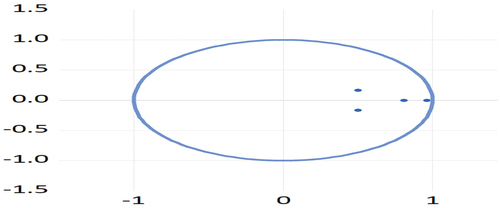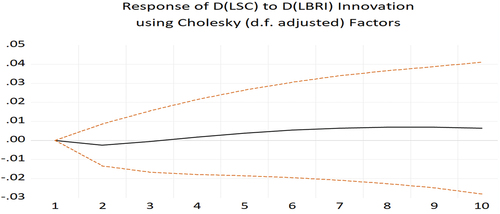 ?Mathematical formulae have been encoded as MathML and are displayed in this HTML version using MathJax in order to improve their display. Uncheck the box to turn MathJax off. This feature requires Javascript. Click on a formula to zoom.
?Mathematical formulae have been encoded as MathML and are displayed in this HTML version using MathJax in order to improve their display. Uncheck the box to turn MathJax off. This feature requires Javascript. Click on a formula to zoom.ABSTRACT
The Belt and Road Initiative (BRI) is a key component of China’s future international trading network. Through the Suez Canal (SC), the Maritime Silk Road Initiative (MSRI) links China to other parts of Asia, Africa, and Europe, making it a major route for global seaborne trade. This is because of the SC’s unique location on the MSRI. This study uses annual data from 1990 to 2022 to examine this dynamic relationship. We use the Vector Auto-Regressive (VAR) model and Impulse Response Function to account for the interaction effect of the variables. Model results show that China’s seaborne trade will increase SC trade by 23%, and China’s BRI investment projects are anticipated to have a significant impact on SC cargo trade in the medium and long run. Developing more value-added services in adjacent regions and attracting large Chinese investments might make the SC a worldwide logistics and a green energy hub.
1. Introduction
Several positive developments have occurred since President Xi Jinping presented the BRI in 2013. Over the last decade, about a trillion dollars have been raised, and over three thousand cooperation projects have been initiated as part of the BRI, which links Asia, Europe, and Africa. According to the World Bank (Citation2019), almost 35% of worldwide FDI is concentrated in economies along the BRI corridor, and 53% of global seaborne trade passes through these ports.
China started the BRI to boost transcontinental connectivity, trade, and economic growth. China’s economic restructuring relies on the BRI’s energy supply, international collaboration, and international trade network. China’s investments along the new MSRI are a strategic move to increase its influence over the Sea Lanes of Communications and the interconnected global value chains of maritime transportation. Currently, the MSRI is actively engaged in mitigating the risks associated with overdependence on established transportation pathways. The creation of alternative routes that can get around any bottlenecks is achieving this (Haralambides & Merk, Citation2020).
The significance and importance of global waterways as crucial maritime hubs cannot be overstated, since they facilitate the transportation of more than 80% of international trade (Sirimanne et al., Citation2023). Their efforts have resulted in a significant reduction in logistical expenses while also ensuring efficient transit durations. Throughout history, numerous instances of maritime infrastructure have undeniably played a pivotal role in facilitating international trade. The SC has successfully decreased shipping times and transportation costs associated with trade between Asia and Europe, as T. Notteboom et al. (Citation2020) demonstrate.
The grounded incident involving the container ship “Ever Given” at the end of March 2021 provides convincing evidence of the SC’s crucial role in global maritime trade (J. M. Y. Lee & Wong, Citation2021). In comparison to other available options, the shortest route connecting the East and West is the SC. The utilization of the Canal route offers advantages in terms of time efficiency, reduced distance, decreased fuel consumption, and overall cost savings.
The SC supports the maritime industry through continuous development. The SC has undergone numerous expansion projects, including double-tracking and deepening. On 6 August 2015, the newly constructed SC, which took a year to complete, was inaugurated. The proposed waterway was to run in parallel with the current canal for a total distance of 72 kilometers. The project’s ultimate goal is to enlarge the canal’s navigable length from 80.5 km to 111.2 km, allowing ships to sail freely in both directions. The expansion of the SC increased daily crossing capacity from 49 to 93 vessels and cut transit time from 18 to 11 hours (Shibasaki et al., Citation2016). This allows 93% of the world’s dry bulk cargo fleet, including 63% of the tanker fleet, 100% of the container fleet, and 100% of other ship types, to pass through (Laih et al., Citation2022).
According to the MSRI literature that is currently available, no research has yet been done to examine the impact of the MSRI on the SC. The existing literature has paid limited attention to the ramifications of the SC within the framework of the MSRI. This research study hopes to address this existing knowledge gap by introducing the concept of the SC within the framework of the MSRI. This study contributes to the literature in four significant ways. To begin with, the analysis utilizes a novel variable known as China BRI Investment Projects in lieu of China’s outward FDI to represent the tangible BRI investment projects. Furthermore, this article introduces an innovative methodology for calculating the MSRI by analyzing China’s maritime trade and investments facilitated by the MSRI with the intention of determining their influence on the SC. In addition, it incorporates the SC ongoing development projects, double parts, and the New Suez Canal project, combining them for the first time as a novel variable in the new SC development projects. As well, in order to examine the correlation between MSRI and international trade via the SC, a VAR model and an IRF are employed.
The design of the paper is explained below. Section 2 is a review of the relevant literature, while Section 3 presents the MSRI and SC, Section 4 analyzes the data and methods, Section 6 discusses and interprets the empirical results, and Section 6 provides the conclusion and directions for further research.
2. Literature review
Early BRI research focused on geopolitics, according to Ferrari and Tei (Citation2020). Scholarly study on trade and shipping has increased to predict future effects on trade volumes, flows, shipping costs, and operational effectiveness. The BRI has been the subject of over 800 scientific studies in the past decade. Shipping economics, international trade, logistics, and supply chains are covered in these works. These works include literature reviews conducted by Lee et al. in (Citation2018), (Citation2020), and (Citation2022), as well as research conducted by Wang et al. in Citation2020 and Citation2021, Jiang et al. in (M. Jiang et al., Citation2023), and Saeed et al. in (Saeed et al., Citation2023).
Haralambides and Merk (Citation2020) explain the BRI’s main goals. Du and Zhang (Citation2018), Nugent and Lu (Citation2021), and Peng et al. (Citation2021) assessed the BRI from a Chinese perspective, finding that execution of the BRI has a substantial impact on international shipping and that maritime trade plays an essential strategic role in the BRI. The abbreviated duration of the BRI implies that numerous launched projects are improbable to have yielded substantial benefits (Saeed et al., Citation2021). The BRI is expected to restructure maritime networks and change global seaborne trade, including the relocation of major waterways and ports, according to Lee et al. (Citation2018). Completed BRI projects will increase regional and global trade by linking previously secluded and isolated developing regions like the Indian subcontinent (Alam et al., Citation2019), South-East Asia (Mueller, Citation2019), and Africa (Chen et al., Citation2020; P. T. W. Lee, Citation2016). By combining the two types of shipping transport, Yang et al. (Citation2020) recreate the Asian-European shipping network.
As reported by Hoffmann et al. (Citation2020), several BRI countries anticipate that enhanced maritime infrastructure will increase international trade, decrease transaction costs, and facilitate greater national participation in the global supply chain. Depending on the country, BRI-related investments and infrastructure improvements are expected to enhance trade flows by 2.7% to 9.7% (De Soyres et al., Citation2019) and by 4.1% (Baniya et al., Citation2020).
Academic interest in the SCE has lagged behind that in the BRI. Feyrer (Citation2021), using a gravity model to analyze data collected between 1967 and 1975, found that the SC’s closure had a negative impact on both trade and revenue. Mostafa (Citation2004) analyzed SC traffic and created traffic projections using univariate ARIMA and neural network models, and he used this information to draw conclusions about the trend of marine traffic patterns from the Canal’s reopening in 1975 until 1998. Gao and Lu (Citation2019) looked at how expensive it was to transfer the Chinese fleet by closing off nine waterways.
According to Akakura & Onon (Citation2020), Pakistan and India reaped the greatest rewards from the canal in 2018. Using an aggregated logit model, Shibasaki et al. (Citation2016) and (Shibasaki et al., Citation2017) explain the variety of global route options available to shipping corporations, focusing on market share for each route. Market share shifts from the SC route to the NSR and train were the primary subject of Zhu et al. (Citation2018) study. Zeng et al. (Citation2020) investigated competition for transporting cargo between Asia and Europe, focusing on the NSR, the SC route, and the railway. T. E. Notteboom (Citation2012) contrasted the SC route with the Cape route.
Scholars agree that the BRI affects maritime trade, although few VAR model evaluations have been published. B. Jiang et al. (Citation2018) assessed shipping costs and MSR exports across all five shipping lanes using the VAR model. Wangping and Xiaolu (Citation2018) created a VAR model to study how FDI, trade, and exports affect China and Japan. Paderon and Ang (Citation2020) use a VAR model to analyze China’s BRI’s economic impacts on the Philippines. This motivates us to probe the link between the SCE and the BRI using the VAR model.
3. The maritime silk road initiative, Suez Canal and Sino-Egyptian relations
3.1. Maritime silk road initiative’s impact on global seaborne trade
China’s investment in BRI projects and countries has grown rapidly in recent years. From 2013 to 2022, shows that over 64% of China’s outbound FDI will be invested in the BRI.
Figure 1. Share of China’s BRI investment in China’s outward FDI (2005–2022).
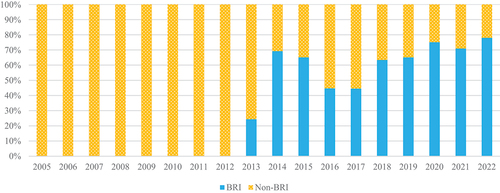
Important investment projects along the BRI have been moving forward regularly. and illustrate the growing interest in energy trading and transportation projects across the globe, especially in East and West Asia and Sub-Saharan Africa. shows that by 2022, China’s percentage of world maritime trade had increased to 25.5%. Chinese seaborne imports climbed to 2.5 bt, representing 21% of total global imports, up from 1.8 bt in 2012. China’s maritime exports rose to 582 mt, up from 480 mt in 2012, and now make approximately 5% of the world’s total.
Figure 2. China’s BRI investment by sector (2013–2022) ($m).
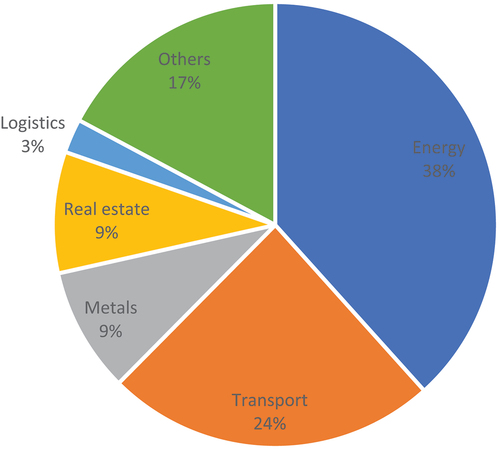
Figure 3. China’s BRI investment by region (2013–2022) ($m).
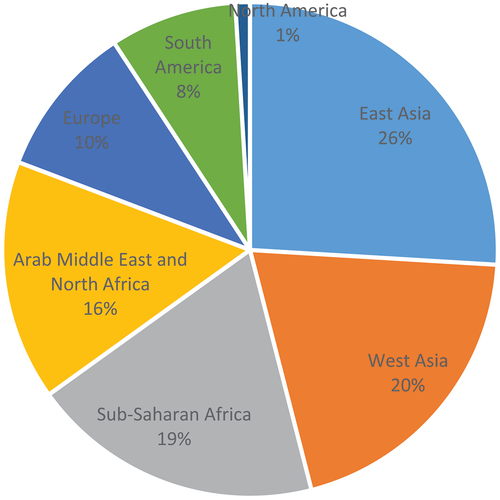
3.2. The Suez Canal’s role in global maritime trade
The SC, situated in the Arab Republic of Egypt, is an essential element of infrastructure for international maritime transport. The SC is a man-made waterway that stretches for 194 kilometers between the Mediterranean and the Red Seas. Trade between Europe and Asia, in particular, has greatly benefited from it since its opening in 1869. shows that the SC can shorten the distance savings by ranging from 22 percent to 47 percent compared to the Cape of Good Hope for BRI countries.
Table 1. Cape of good hope vs. Suez canal BRI distance savings.
“EVER GIVEN,” a massive container ship, ran aground in the SC on 23 March 2021, blocking traffic in both directions. As a result, the canal’s closure had a significant impact on the $400 million in value of goods transported every hour. The closure lowered yearly worldwide trade growth by 0.2% to 0.4%, and $9.6 billion in goods pass through the canal daily. Since the SC carries over $1 trillion worth of goods annually (Fan et al., Citation2022), its grounding has highlighted the importance of the SC for global supply networks and seaborne trade.
Every year, the SC can transport approximately more than one billion tons of food, medicine, fuel, and other human necessities. In 2022, approximately 23,851 vessels totaling 1.2 billion tons passed through the SC in both directions (Canal Authority, Citation2023). As shown in and , container vessels accounted for the largest share of cargo tonnage (474 million tons, or 40.3% of the total).
Figure 5. Share of the SC transit numbers by vessel type in 2022.
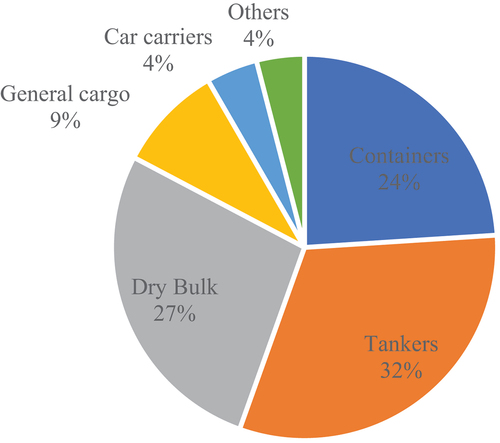
Figure 6. Share of the SC cargo trade by vessel type in 2022.
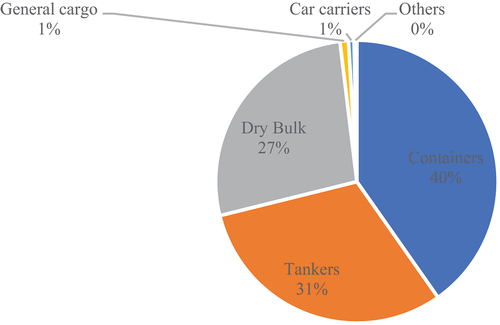
3.3. Sino-Egyptian relations
China and Egypt have maintained an implicit economic collaborative relation and provided mutual support since 1956, and created an energy-dominated cooperation pattern. Egypt is a BRI Africa-West Asia supporter. In order to foster better relations, advance the BRI, adjust bilateral policies, and execute novel economic strategies, it is imperative that both Egypt and China intensify their bilateral ties in the twenty-first century. Egypt is an appropriate partner for the BRI on account of its participation in the MSRI. The Egypt 2030 Plan and the BRI are mutually supportive. Both China and Egypt endorse that the SC Corridor, which serves as the new administrative capital, exhibits encouraging development prospects in relation to renewable energy and other related issues (Tanyi-Tang, Citation2021).
Egypt-China relations are boosted by trade. From $900 million in 2000 to $13.2 billion in 2019, bilateral trade increased significantly. Contrary to the impact of COVID-19, China-Egypt trade increased by 10.34% to $14.566 billion in 2020. China’s imports from Egypt consist of oil, liquefied petroleum gas (LPG), agricultural commodities, and textile and apparel items. Furthermore, Egypt imports technological and electrical products (Rapanyane, Citation2021).
China and Egypt have established the TEDA Cooperation Zone, a significant economic and commercial initiative that focuses on foreign investment, manufacturing capacity, and special zones. The TEDA serves as a landmark endeavor for bilateral economic and trade collaboration and is the preeminent industrial development park within the SC Economic Zone. Over the previous 14 years, it has attracted $1 billion in Chinese investment, created 4,000 local jobs, and greatly improved resource allocation (Bi et al., Citation2023). Egypt’s present strategy toward China, which is defined by amiable and growing bilateral relations, is expected to continue. China and Egypt will maintain good relations and work toward mutual prosperity.
4. Data and methodology
4.1. Data description
This article chooses the SC cargo trade annual data given by the Suez Canal Authority (SCA) from 1990 to 2022, for a total of 33 period data for empirical analysis, to delve into the connection between the MSRI and the SC. Other variables included China’s seaborne trade, China’s BRI investment projects, and SC’s new development projects. lists variables, indicators, and data sources. shows variable descriptive statistics before logarithmic adjustment.
Table 2. Variables considered, their indicators, and sources.
Table 3. Variable descriptive statistics.
4.2. Unit root test
The stationarity of each variable in a VAR model must be checked. The Augmented Dickey-Fuller (ADF) test (Dickey & Fuller, Citation1979, Citation1981) is the most often used unit root test for time series. shows the outcomes of a unit root test for the ADF with the most important variables.
Table 4. ADF test results.
shows that every variable except China’s seaborne trade is stationary at the first difference level, while the latter is not. Without doing a separate cointegration test, the level series can be used to estimate regressions in causality analysis (Said & Dickey, Citation1984).
4.3. The VAR model
The VAR model, which Sims (Citation1980) developed, is widely employed in the study of causal relationships between variables. It uses a linear combination of the lags of a group of endogenous variables to characterize their change over time. To be more specific, the progression of each endogenous variable depends on the lagging components of not just the other endogenous variables but also the controlled variables. We use a VAR (p) model to examine the factors that influence SC cargo trade by evaluating the relationship between their p-lag variables. This model includes China’s seaborne trade, BRI investment, and SC’s new development projects as multivariables.
The set of equations below is estimated using the VAR (p) model. The generic VAR model can be written as follows if the lag order is p and Xt is an endogenous variable with dimensions (4 × 1):
where C is a constant vector with dimensions of 4 × 1, Xt is a column vector of controlled variables with dimensions of 4 × 1, p represents the order of lags, each B1, B2, … , Bp denotes a coefficient matrix with dimensions of 4 × 4, each of Xt-1, Xt-2, … , Xt-p entails a vector of lag endogenous variables with dimensions of 4 × 1, Ae is the matrix of Zt coefficients and t is the vector of random error terms in the system with dimensions of 4 × 1.
After transforming all variables into natural logarithm form and accounting for controlled variables, the VAR model presented in this paper is expressed as follows:
As can be seen in , the lag length of VAR p is selected using the minimal Akaike Information Criterion (AIC), with a maximum lag of 1.
Table 5. Selection criteria for the VAR lag order.
The stability of the VAR model is maximized since all inverse roots of the characteristic polynomial of AR are less than 1. Furthermore, as can be shown in , it provides a useful model for illustrating the interaction between various components.
shows that if SC trade increases by 1% compared to the previous year, it will increase by 69% this year. Rising navigational safety standards, the reliability of SC operations, and the ongoing increase in global demand for goods and commodities are all factors in this evolution. China’s seaborne trade is predicted to increase SC trade by 23%, while China’s BRI investment projects are likely to have a major positive influence of 5% on SC trade. Every 1% increase in the number of construction projects in the SC will result in a 3% increase in cargo trade.
Table 6. The VAR model results.
4.4. Granger causality test
In this paper, we utilize the Granger causality test according to the VAR findings to check for a Granger causal relation between the variables of SC trade and BRI. shows a robust connection between China’s seaborne trade, China’s BRI investment, and SC’s new development projects.
4.5. Impulse response function
4.5.1. The impact of China’s seaborne trade on SC cargo trade
shows the impulse response function of China’s seaborne trade shocks on SC cargo trade. The vertical axis depicts shock impact, whereas the horizontal axis shows annual frequency. The findings show that China’s seaborne trade positively affects SC cargo trade in the short, medium, and long run, with a progressive increase until period 10 and a peak in the tenth year.
4.5.2. The impact of China’s BRI investment on SC cargo trade
The China BRI investment shock has a stable effect on SC cargo trade over a one-year period. This effect begins to decline in the second and third years and turns positive in the fourth year, with a positive and stable effect in the long run. See .
4.5.3. The impact of SC new development projects on SC cargo trade
For an illustration of how the SC new development project shock affected SC cargo trade, see . The data suggests that there is a positive and consistent influence on SC cargo trade in the first and second years following the SC new development project shock, with the effect gradually increasing until period 3 and peaking in years 3 and 4. This beneficial effect lasted through the fourth year, then tapered off in the years that followed, although its positive aftereffects remained.
5. Empirical results
This study reveals the direct relation between the MSRI and the SC cargo trade in the short run. It shows that there will be a 23% increase in SC cargo trade as a result of Chinese seaborne trade. This may be due to the fact that China’s SC trade will account for 30 percent of the world’s SC cargo trade by 2022. Almost all shipping containers between Asia and Europe pass through the canal. One of the benefits is the reduction in costs related to shipping time, bunker, and maintenance. By passing through the SC instead of around the Cape of Good Hope, MSRI countries can reduce shipping time by 22% to 47% as shown in . Given these findings, it is evident that SC cargo trade and MSRI are highly interdependent.
Moreover, BRI investment projects are forecast to have a medium- to long-term positive impact on the SC of 5 percent. The SC’s strategic location along the MSRI between Asia, Africa, and Europe is a major factor in this. De Soyres et al. (Citation2019) estimate that shipping makes up about 83.1% of BRI countries’ total trade routes. The SC’s value-added services have the potential to grow in parallel with the shipping trade. If more value-added activities are established in the surrounding areas of SC, it has the potential to become a global logistics hub. If Egypt is to be turned from a trade gateway into a global hub, it will need to attract substantial Chinese investments in the SC region.
The ongoing expansion projects of the SCA, such as the New SC and developing the Southern Sector, which take into account all developments related to the growing global maritime fleet, have an increasing impact on the trade passing through the SC. This is because of the reduction in transit waiting time and the increase in navigational safety owing to ongoing development projects. Consequently, the SC is required to evaluate its development plans for the expansion of the waterway every four years and implementation every ten years before the negative impact begins. According to these findings, the SC needs to adopt flexible pricing and marketing strategies in order to promote and attract more customers to transit the SC. As a result, the SC needs to continue with its waterway expansion strategies to accommodate the increase in both Chinese seaborne trade and BRI investment projects. Therefore, it is essential to maintain and enhance the marketing value of the SC as an international public asset that promotes global trade while supporting the Egyptian economy.
The BRI projects as a whole are expected to boost the seaborne trade of raw materials, especially dry bulk cargoes, in addition to enabling China to diversify its energy supply networks. To better place BRI countries in the international trading network and lay the groundwork for the future trade network, new ports and infrastructure networks are being built. They will aid in gaining access to new markets as well. More trade prospects can be expected from BRI projects. New shipping routes between China and Europe are anticipated to be created as a result of these developments, which will have a major effect on global shipping and SC, and this accords with the results of the study (Haralambides & Merk, Citation2020).
The SC plays a crucial role in international trade for both commercial and strategic reasons. About 10% of all maritime traffic, 23% of all fleet, 15% of all grains pass via the Canal. Moreover, the significance of the SC differs across different maritime sectors. It is estimated that the Canal facilitates the transit of over 25% of container seaborne trade. Approximately one-third of containership capacity is used on services scheduled to use the Canal, and 45% of containership tonnage has passed through the Canal in the 2022. Typically, 14% of the total capacity of the car carrier fleet transits the Canal each year. This compares to 10% for LNG carriers, 9% for oil tankers, 7% for LPG carriers, and 4% for bulk carriers (Canal Authority, Citation2023). These findings emphasize the significance of the worldwide maritime trade for the SC, and the need for the SC arises from the global maritime trade. These insights indicate that the important role of the SC in international trade stems from its dual benefits.
Although the MSRI will have a positive effect on the SC due to an increase in Chinese trade and investments, it is also anticipated to have a little negative effect on the SC due to, for example, an increase in railway transport between China and Europe, an increase in intra-trade among China and Asian countries, and the expectation that new pipeline construction will increase China’s land-based oil imports. New refineries built in MSRI nations could increase crude imports and pipeline product exports. China is presently undergoing the construction of new LNG pipelines.
6. Conclusion
Since the MSRI’s proposal in 2013, China has been investing in energy, transportation infrastructure, metals, and logistic hubs along the MSRI’s economic corridors. This new feature enhances the convenience and availability of international shipping routes, especially those connecting China and Europe via the SC.
In light of China’s MSRI, this study analyzes the SC with a particular focus on cargo trade, China’s maritime trade, China’s BRI investment, and the SC’s new development projects. The VAR model was built using data from the World Bank, the SCA, Clarksons Research, and the China Global Investment databases. The model reflected recent developments in the SC cargo trade, such as China BRI investment and SC new development projects, by using input data acquired from a variety of data sources. The recommended annual data in this paper spans the years 1990 through 2022. To shed light on the cause of the observed interaction effect among all variables, a VAR model is calculated alongside the impulse response.
The results indicate that BRI investment projects will have a medium- to long-term positive impact on SC beginning in the fourth year. Therefore, it is essential that SC development coincide with anticipated shifts in global seaborne trade, especially Chinese seaborne trade. The SC’s ongoing expansion projects, which have a growing impact on trade passing through the SC, account for all changes related to the growth of the world’s maritime fleet. Therefore, the SC needs to review its expansion plans for the waterway every four years and its implementation every ten years before the adverse effects become noticeable.
The VAR model used to explain MSRI and SC cargo trade in this study, as well as the methods used to estimate them, are both first steps and prototypes. The study’s approach, model, and level of information and analysis are all inadequate. However, the paper did not dissect the significance of China’s MSRI on the SC by vessel type (container, dry bulk, tanker, gas, etc.) or the influences of China’s MSRI and the SC on the recently launched India-Middle East-Europe Economic Corridor (IMEC), which seeks to increase connectivity and trade between India, the Arabian Gulf, and Europe. Subsequent research endeavors may contemplate green trends, including the international maritime organization’s (IMO) objective of attaining “net zero” emissions, green belt and road sustainability, and the SC economic corridor.
In addition to IMO, SC operators and port operators, maritime economists, and insurance companies concerned with mitigating hazards in the marine industry would benefit from knowing how China’s MSRI will affect SC. It would be extremely helpful for any stakeholder to understand the global maritime shipping market dynamics if the influence of China’s MSRI could be evaluated globally on a ship type basis instead of just on the overall SC through coordination with trade statistics.
Disclosure statement
No potential conflict of interest was reported by the author(s).
Additional information
Notes on contributors
Anas Rakha
Anas Rakha, PhD Candidate at Faculty of Economics and Political Science, Cairo University, Giza, Egypt. Email:[email protected]
Khadiga El-Aasar
Khadiga El‑Aasar, Professor Emeritus at Faculty of Economics and Political Science, Cairo University, Giza, Egypt. Email: [email protected]
References
- AKAKURA, Y., & K, O. N. O. (2020, June). Estimation of economic benefit of major chokepoint on global trade and economy is the benefit of the Malacca Strait larger than that of the Suez/Panama canal?. IAME 2020 Conference. https://www.ysk.nilim.go.jp/kakubu/kouwan/system/2020_01.pdf
- Alam, K. M., Li, X., & Baig, S. (2019). Impact of transport cost and travel time on trade under China-Pakistan economic corridor (CPEC). Journal of Advanced Transportation, 2019, 1–17. https://doi.org/10.1155/2019/7178507
- Baniya, S., Rocha, N., & Ruta, M. (2020). Trade effects of the new silk road: A gravity analysis. Journal of Development Economics, 146, 102467. https://doi.org/10.1016/j.jdeveco.2020.102467
- Bi, M., Zhang, Z., Wei, G., & Liu, B. (2023). On the Sino-Egyptian geo-relations in the perspective of the belt and road——based on event data analysis. Cogent Social Sciences, 9(1), 2160535. https://doi.org/10.1080/23311886.2022.2160535
- Canal Authority, S., (2023). Canal characteristics. Retrieveddate September 1, 2023. Retrieved from https://www.suezcanal.gov.eg/English/Pages/default.aspx
- Chen, K., Xu, S., & Haralambides, H. (2020). Determining hub port locations and feeder network designs: The case of China-West Africa trade. Transport Policy, 86, 9–22. https://doi.org/10.1016/j.tranpol.2019.12.002
- De Soyres, F., Mulabdic, A., Murray, S., Rocha, N., & Ruta, M. (2019). How much will the belt and road initiative reduce trade costs? International Economics, 159, 151–164. https://doi.org/10.1016/j.inteco.2019.07.003
- Dickey, D. A., & Fuller, W. A. (1979). Distribution of the estimators for autoregressive time series with a unit root. Journal of the American Statistical Association, 74(366a), 427–431. https://doi.org/10.1080/01621459.1979.10482531
- Dickey, D. A., & Fuller, W. A. (1981). Likelihood ratio statistics for autoregressive time series with a unit root. Econometrica: Journal of the Econometric Society, 49(4), 1057. 1057-1072. https://doi.org/10.2307/1912517
- Du, J., & Zhang, Y. (2018). Does one belt one road initiative promote Chinese overseas direct investment? China Economic Review, 47, 189–205. https://doi.org/10.1016/j.chieco.2017.05.010
- Fan, S., Yang, Z., Wang, J., & Marsland, J. (2022). Shipping accident analysis in restricted waters: Lesson from the Suez Canal blockage in 2021. Ocean Engineering, 266, 113119. https://doi.org/10.1016/j.oceaneng.2022.113119
- Ferrari, C., & Tei, A. (2020). Effects of BRI strategy on Mediterranean shipping transport. Journal of Shipping and Trade, 5(1), 14. https://doi.org/10.1186/s41072-020-00067-x
- Feyrer, J. (2021). Distance, trade, and income—the 1967 to 1975 closing of the Suez Canal as a natural experiment. Journal of Development Economics, 153, 102708. https://doi.org/10.1016/j.jdeveco.2021.102708
- Gao, T., & Lu, J. (2019). The impacts of strait and canal blockages on the transportation costs of the Chinese fleet in the shipping network. Maritime Policy & Management, 46(6), 669–686. https://doi.org/10.1080/03088839.2019.1594423
- Haralambides, H. E., & Merk, O. (2020). The belt and road initiative: Impacts on global maritime trade flows. International Transport Forum Discussion Paper. https://doi.org/10.1787/2223439X.
- Hoffmann, J., Saeed, N., & Sødal, S. (2020). Liner shipping bilateral connectivity and its impact on South Africa’s bilateral trade flows. Maritime Economics & Logistics, 22(3), 473–499. https://doi.org/10.1057/s41278-019-00124-8
- Jiang, B., Li, J., & Gong, C. (2018). Maritime shipping and export trade on “maritime silk road”. The Asian Journal of Shipping and Logistics, 34(2), 83–90. https://doi.org/10.1016/j.ajsl.2018.06.005
- Jiang, M., Liu, Y., Lu, J., Qu, Z., & Yang, Z. (2023). Risk assessment of maritime supply chains within the context of the maritime silk road. Ocean & Coastal Management, 231, 106380. https://doi.org/10.1016/j.ocecoaman.2022.106380
- Laih, C. H., Chuang, Y. F., Wang, R. C., & Sun, P. Y. (2022). Development of an adjustable step toll scheme in compliance with expected effects of queuing reduction for the suez canal. Research in Transportation Business & Management, 44, 100717. https://doi.org/10.1016/j.rtbm.2021.100717
- Lee, P. T. W. (2016). China’s growing engagement in the emerging maritime logistics market in Africa. Dynamic Shipping and Port Development in the Globalized Economy: Volume 1: Applying Theory to Practice in Maritime Logistics, 39–68. https://doi.org/10.1057/9781137514233
- Lee, P. T. W., Hu, Z. H., Lee, S. J., Choi, K. S., & Shin, S. H. (2018). Research trends and agenda on the belt and road (B&R) initiative with a focus on maritime transport. Maritime Policy & Management, 45(3), 282–300. https://doi.org/10.1080/03088839.2017.1400189
- Lee, P. T. W., Hu, Z. H., Lee, S., Feng, X., & Notteboom, T. (2022). Strategic locations for logistics distribution centers along the belt and road: Explorative analysis and research agenda. Transport Policy, 116, 24–47. https://doi.org/10.1016/j.tranpol.2021.10.008
- Lee, J. M. Y., & Wong, E. Y. C. (2021). Suez Canal blockage: An analysis of legal impact, risks and liabilities to the global supply chain. In MATEC web of conferences (Vol. 339, p. 01019). EDP Sciences. https://doi.org/10.1051/matecconf/202133901019
- Lee, P. T. W., Zhang, Q., Suthiwartnarueput, K., Zhang, D., & Yang, Z.(2020). Research trends in Belt and Road Initiative studies on logistics, supply chains, and transportation sector. International Journal of Logistics: Research & Applications, 23(6), 525–543. https://doi.org/10.1080/13675567.2020.1828318
- Mostafa, M. M. (2004). Forecasting the Suez Canal traffic: A neural network analysis. Maritime Policy & Management, 31(2), 139–156. https://doi.org/10.1080/0308883032000174463
- Mueller, L. M. (2019). ASEAN centrality under threat–the cases of RCEP and connectivity. Journal of Contemporary East Asia Studies, 8(2), 177–198. https://doi.org/10.1080/24761028.2019.1691703
- Notteboom, T. E. (2012). Towards a new intermediate hub region in container shipping? Relay and interlining via the Cape route vs. The Suez route. Journal of Transport Geography, 22, 164–178. https://doi.org/10.1016/j.jtrangeo.2012.01.003
- Notteboom, T., Pallis, A., & Rodrigue, J. P. (2020). Port economics, management and policy. Routledge. https://doi.org/10.4324/9780429318184
- Nugent, J. B., & Lu, J. (2021). China’s outward foreign direct investment in the belt and road initiative: What are the motives for Chinese firms to invest? China Economic Review, 68, 101628. https://doi.org/10.1016/j.chieco.2021.101628
- Paderon, M. M., & Ang, R. B., III. (2020). Possible effects of China’s belt and road initiative on Philippine trade and investments. https://pids.gov.ph/publications/7107
- Peng, H. R., Qi, S. Z., & Zhang, Y. J. (2021). Does trade promote energy efficiency convergence in the belt and road initiative countries? Journal of Cleaner Production, 322, 129063. https://doi.org/10.1016/j.jclepro.2021.129063
- Rapanyane, M. B. (2021). Key drivers of China’s Egypt engagement in the context of the Suez Canal: An afrocentric point of view. Journal of African Foreign Affairs, 8(1), 97. https://doi.org/10.31920/20565658/2021/v8n1a5
- Saeed, N., Cullinane, K., Gekara, V., & Chhetri, P. (2021). Reconfiguring maritime networks due to the belt and road initiative: Impact on bilateral trade flows. Maritime Economics & Logistics, 23(3), 381–400. https://doi.org/10.1057/s41278-021-00192-9
- Saeed, N., Nguyen, S., Cullinane, K., Gekara, V., & Chhetri, P. (2023). Forecasting container freight rates using the prophet forecasting method. Transport Policy, 133, 86–107. https://doi.org/10.1016/j.tranpol.2023.01.012
- Said, S. E., & Dickey, D. A. (1984). Testing for unit roots in autoregressive-moving average models of unknown order. Biometrika, 71(3), 599–607. https://doi.org/10.1093/biomet/71.3.599
- Shibasaki, R., Azuma, T., Yoshida, T., Teranishi, H., & Abe, M. (2017). Global route choice and its modelling of dry bulk carriers based on vessel movement database: Focusing on the Suez Canal. Research in Transportation Business & Management, 25, 51–65. https://doi.org/10.1016/j.rtbm.2017.08.003
- Shibasaki, R., Yoshida, T., & Azuma, T. (2016). Route choice of containership on a global scale and model development: Focusing on the Suez Canal. Route Choice of Containership on a Global Scale and Model Development: Focusing on the Suez Canal, 265–290. https://www.torrossa.com/en/resources/an/3155992
- Sims, C. A. (1980). Macroeconomics and reality. Econometrica: Journal of the Econometric Society, 48(1), 1–48. https://doi.org/10.2307/1912017
- Sirimanne, S. N., Hoffman, J., Juan, W., Asariotis, R., Assaf, M., Ayala, G. & Premti, A. (2023, September). Review of maritime transport 2023. In United Nations conference on trade and development, Geneva, Switzerland. https://unctad.org/publication/review-maritime-transport-2023
- Tanyi-Tang, G. (2021). The Economic and Strategic Impact of China’s Rising Influence in Africa: A Case Study in Nigeria and Zambia [ Master’s thesis]. Eastern Mediterranean University (EMU)-Doğu Akdeniz Üniversitesi (DAÜ). http://hdl.handle.net/11129/5675.
- Wangping, Y., & Xiaolu, L. (2018). Study on the interaction between China and Japan’s economy based on FDI, import and export trade. Studies in Business and Economics, 13(1), 194–208. https://doi.org/10.2478/sbe-2018-0015
- Wang, X., Wong, Y. D., Li, K. X., & Yuen, K. F. (2021). Transport research under belt and road initiative: Current trends and future research agenda. Transportmetrica A: Transport Science, 17(4), 357–379. https://doi.org/10.1080/23249935.2020.1731008
- Wang, X., Wong, Y. D., Yuen, K. F., & Li, K. X. (2020). Environmental governance of transportation infrastructure under belt and road initiative: A unified framework. Transportation Research Part A: Policy and Practice, 139, 189–199. https://doi.org/10.1016/j.tra.2020.03.001
- World Bank. (2019). Belt and road economics: Opportunities and risks of transport corridors. The World Bank. https://doi.org/10.1596/978-1-4648-1392-4
- Yang, Z., Sun, Y., & Lee, P. T. W. (2020). Impact of the development of the China-Europe Railway Express–A case on the Chongqing international logistics center. Transportation Research Part A: Policy and Practice, 136, 244–261. https://doi.org/10.1016/j.tra.2020.03.022
- Zeng, Q., Lu, T., Lin, K. C., Yuen, K. F., & Li, K. X. (2020). The competitiveness of Arctic shipping over Suez Canal and China-Europe railway. Transport Policy, 86, 34–43. https://doi.org/10.1016/j.tranpol.2019.11.005
- Zhu, S., Fu, X., Ng, A. K., Luo, M., & Ge, Y. E. (2018). The environmental costs and economic implications of container shipping on the Northern Sea route. Maritime Policy & Management, 45(4), 456–477. https://doi.org/10.1080/03088839.2018.1443228


